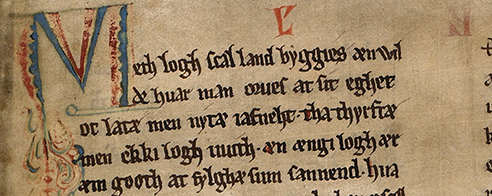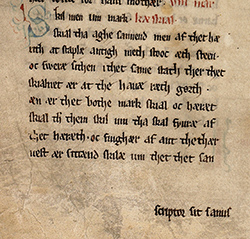2nd of December - Well-wishes from the margin
Behind the second door in our advent calendar we find a scribe to took time out to write a get-well message to his colleague in a copy of the Law of Jutland.

The preface to Jyske Lov begins with the famous words "Meth logh scal land bygges" (With law must a land be built). (Click on the picture to see a larger version.)
In appearance, AM 286 fol. is unlike other Old Danish law codices, which are typically small, compact books seemingly made with easay portability in mind. AM 286 fol. is qute the opposite: large, flat and apparently inted for display. as such it wouold fit in perfectly among various editions of the Constitution of the Kingdom of Denmark which are placed in a display cabinet in the Danish parliament next to (a copy of) a manuscript with the same contents as AM 286 fol., that is Jyske lov, the Law of Jutland. Jyske lov is a regional law code, but it distinguishes itself from other Danish regional law codes in that it was promulgated by the king, Valdemar the Victorious, in March 1241 and it provided with a juridico-philosophical preface which can be considered as a kind of informal constitution. The preface begins with the well-known words "med lov skal land bygges" (with law must a land be built) and has been called the best piece of Danish prose bequeathed to us by the Middle Ages (although it is worth noting that in this case it is based on a Latin source).
AM 286 fol. consists of 24 parchment leaves divided into three quires and contains only the text of Jyske lov with a concluding index. The first leaf and the verso of the later were originally blank and must have served as a cover. The manuscript was probably bound for the first time only in more recent times. The text is laid out in two columns and written in an older gothic bookhand by two contemporary scribes, the second of whom relieves the first between columns 1 and 2 on f. 7v in the middle of a word. The addition scriptor sit sanus (may the writer be healthy) in the lower margin of f. 7v has been interpreted as a sing that the first scribe stopped his work on account of poor health. Nor does the work of these two scribes seem to be particularly well coordinated, since the second scribe has used an exemplar from a different group of manuscripts (with alternative chapter divisions) than that used by the first.
There are a great many features provided to help the reader navigate his or her way round the text: book numers are given as running titles, the beginnings of chapters are marked with floral initials in red and blue, there are red chapter numbers in the margins and red chapter titles.
TParts of this text were previously published in the book 66 manuscripts from the Arnamagnæan Collection.
Contact
Katrín Þórdís Driscoll is a research assistant at the Dept. of Nordic Studies and Linguistics.
Phone: +45 3533 1660
katdris@hum.ku.dk
Britta Olrik Frederiksen is associate professor emerita at the Arnamagnæan Institute.
Phone: +45 35 32 84 72
britta@hum.ku.dk


